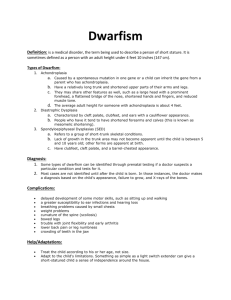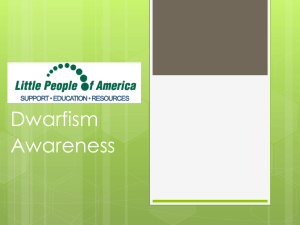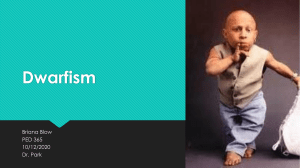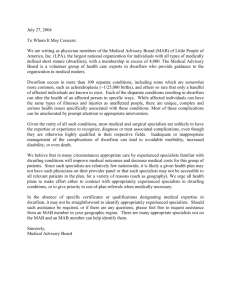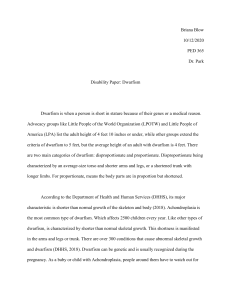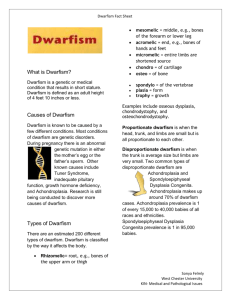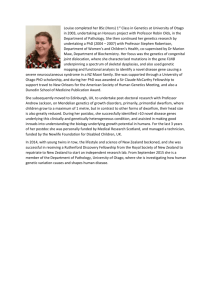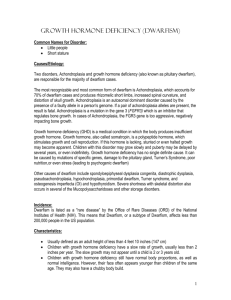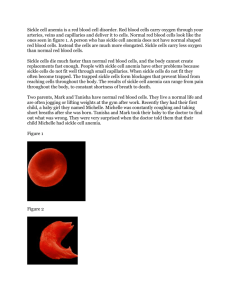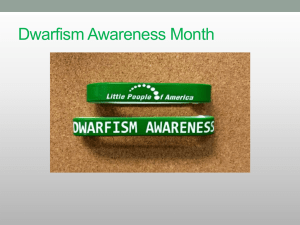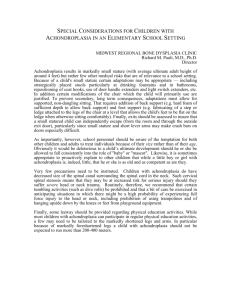Dwarfism - Ms. Cunningham
advertisement
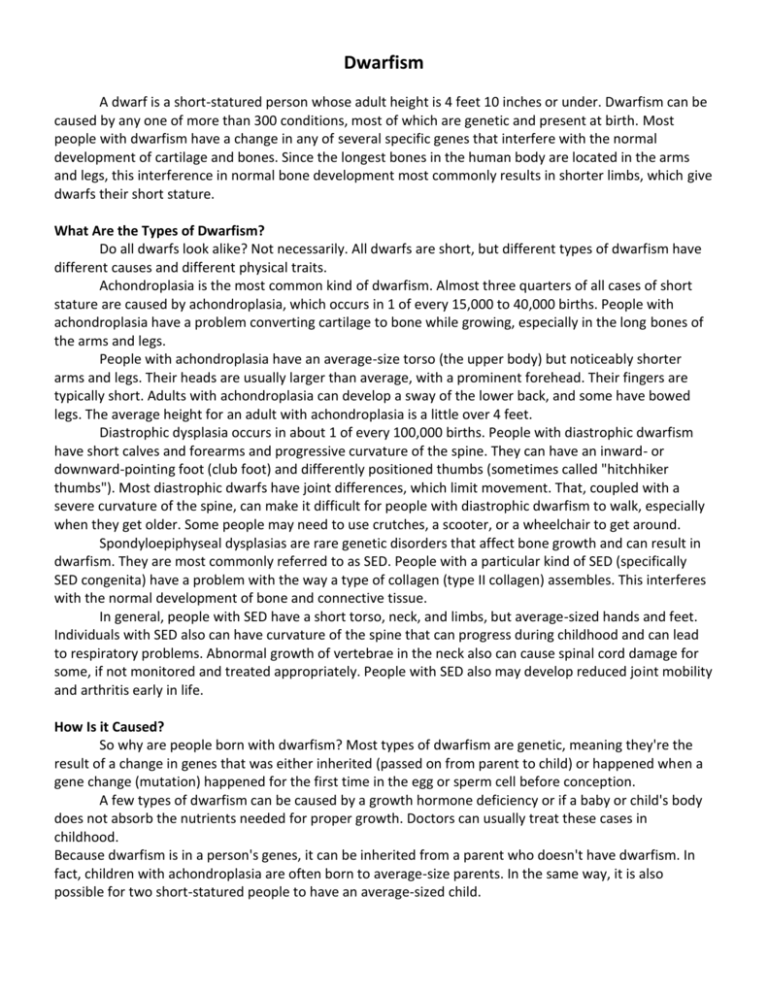
Dwarfism A dwarf is a short-statured person whose adult height is 4 feet 10 inches or under. Dwarfism can be caused by any one of more than 300 conditions, most of which are genetic and present at birth. Most people with dwarfism have a change in any of several specific genes that interfere with the normal development of cartilage and bones. Since the longest bones in the human body are located in the arms and legs, this interference in normal bone development most commonly results in shorter limbs, which give dwarfs their short stature. What Are the Types of Dwarfism? Do all dwarfs look alike? Not necessarily. All dwarfs are short, but different types of dwarfism have different causes and different physical traits. Achondroplasia is the most common kind of dwarfism. Almost three quarters of all cases of short stature are caused by achondroplasia, which occurs in 1 of every 15,000 to 40,000 births. People with achondroplasia have a problem converting cartilage to bone while growing, especially in the long bones of the arms and legs. People with achondroplasia have an average-size torso (the upper body) but noticeably shorter arms and legs. Their heads are usually larger than average, with a prominent forehead. Their fingers are typically short. Adults with achondroplasia can develop a sway of the lower back, and some have bowed legs. The average height for an adult with achondroplasia is a little over 4 feet. Diastrophic dysplasia occurs in about 1 of every 100,000 births. People with diastrophic dwarfism have short calves and forearms and progressive curvature of the spine. They can have an inward- or downward-pointing foot (club foot) and differently positioned thumbs (sometimes called "hitchhiker thumbs"). Most diastrophic dwarfs have joint differences, which limit movement. That, coupled with a severe curvature of the spine, can make it difficult for people with diastrophic dwarfism to walk, especially when they get older. Some people may need to use crutches, a scooter, or a wheelchair to get around. Spondyloepiphyseal dysplasias are rare genetic disorders that affect bone growth and can result in dwarfism. They are most commonly referred to as SED. People with a particular kind of SED (specifically SED congenita) have a problem with the way a type of collagen (type II collagen) assembles. This interferes with the normal development of bone and connective tissue. In general, people with SED have a short torso, neck, and limbs, but average-sized hands and feet. Individuals with SED also can have curvature of the spine that can progress during childhood and can lead to respiratory problems. Abnormal growth of vertebrae in the neck also can cause spinal cord damage for some, if not monitored and treated appropriately. People with SED also may develop reduced joint mobility and arthritis early in life. How Is it Caused? So why are people born with dwarfism? Most types of dwarfism are genetic, meaning they're the result of a change in genes that was either inherited (passed on from parent to child) or happened when a gene change (mutation) happened for the first time in the egg or sperm cell before conception. A few types of dwarfism can be caused by a growth hormone deficiency or if a baby or child's body does not absorb the nutrients needed for proper growth. Doctors can usually treat these cases in childhood. Because dwarfism is in a person's genes, it can be inherited from a parent who doesn't have dwarfism. In fact, children with achondroplasia are often born to average-size parents. In the same way, it is also possible for two short-statured people to have an average-sized child. How Is it Diagnosed? Doctors are able to diagnose most cases of achondroplasia even before birth by doing an ultrasound in the later stages of pregnancy. The ultrasound shows doctors if a baby's arms and legs are shorter than average or if the baby's head is larger. Some other types of dwarfism cannot be diagnosed until after a baby is born. If it's thought a child may have dwarfism, the doctor can use X-rays to see if the bones are growing at an abnormal rate, or if they are shaped differently. What Are Possible Complications and Treatments? There is no cure or specific treatment for dwarfism that's been caused by a genetic disorder. Little people, their families, and their doctors focus on preventing or treating the health conditions that can happen with dwarfism. Different types of dwarfism bring different health concerns. Some of the medical complications associated with dwarfism can require surgery (usually on the back, neck, leg, foot, or middle ear). Because of this, little people usually go through more surgeries than the average-size person, especially as children. These surgeries usually require anesthesia, and that can be more of a risk for people with dwarfism because of their smaller body size and airways, and sometimes associated curvature of the spine. Because of their shorter stature and physical differences in bone growth, children with dwarfism are generally slower to roll over, sit up, crawl, and walk than average-size kids. Their bodies may be a little different and it might take them a little longer, but they do figure out how to do it in their own time and in their own way. A few extra pounds on a little person can be more of a problem than a few extra pounds on an average-size person. Extra weight causes harmful stress on the back and shorter limbs. People with dwarfism can be limited in the types of exercises and activities that they can do, but it's very important for them to find safe physical activities that they enjoy to help prevent even small weight gain. Most of the complications that occur in people with dwarfism are physical in nature and do not affect their intellectual ability. In fact, little people often develop a sense of ingenuity because they often have to find clever ways of doing things in the average-size world. Treatment often includes providing emotional support for people and families living with dwarfism. It's not just that little people have to accept being shorter than most people; they have to learn how to live in a world that is built for average-size people. Short-statured people often have to interact with people unfamiliar with dwarfism who make assumptions about their capabilities without knowing enough about it or getting to know someone with it. For short-statured people, meeting others may be challenging, especially those who are unfamiliar with dwarfism. While it can be tough and awkward at times, it can be a great opportunity to enlighten people who don't know much about dwarfism.
